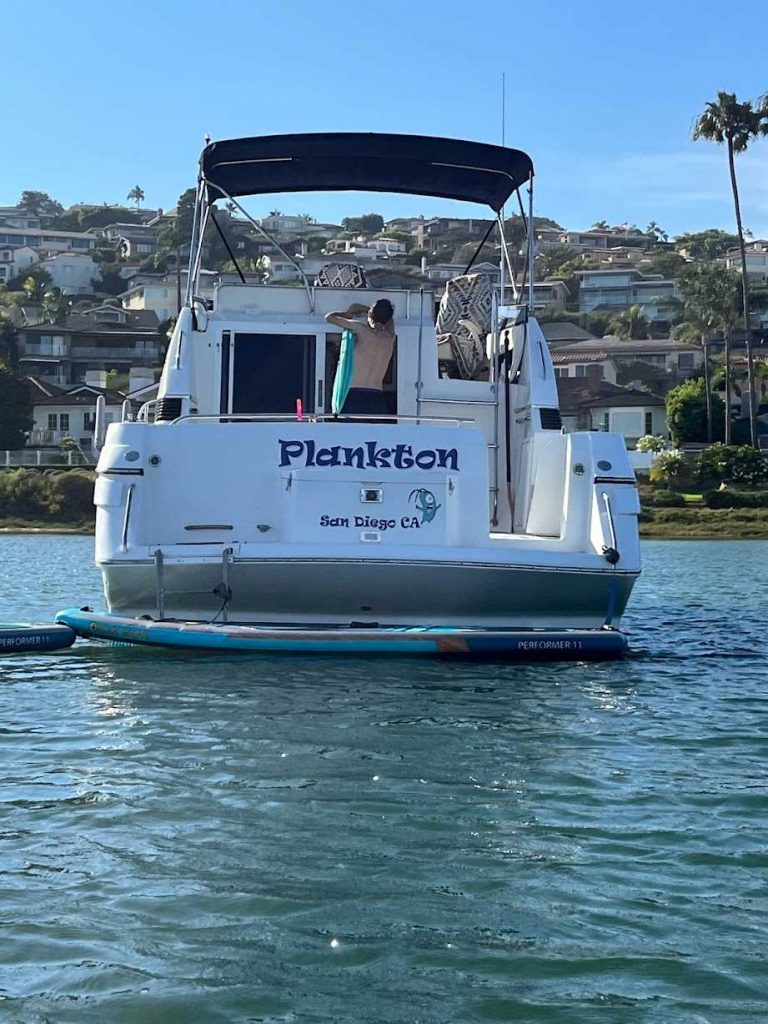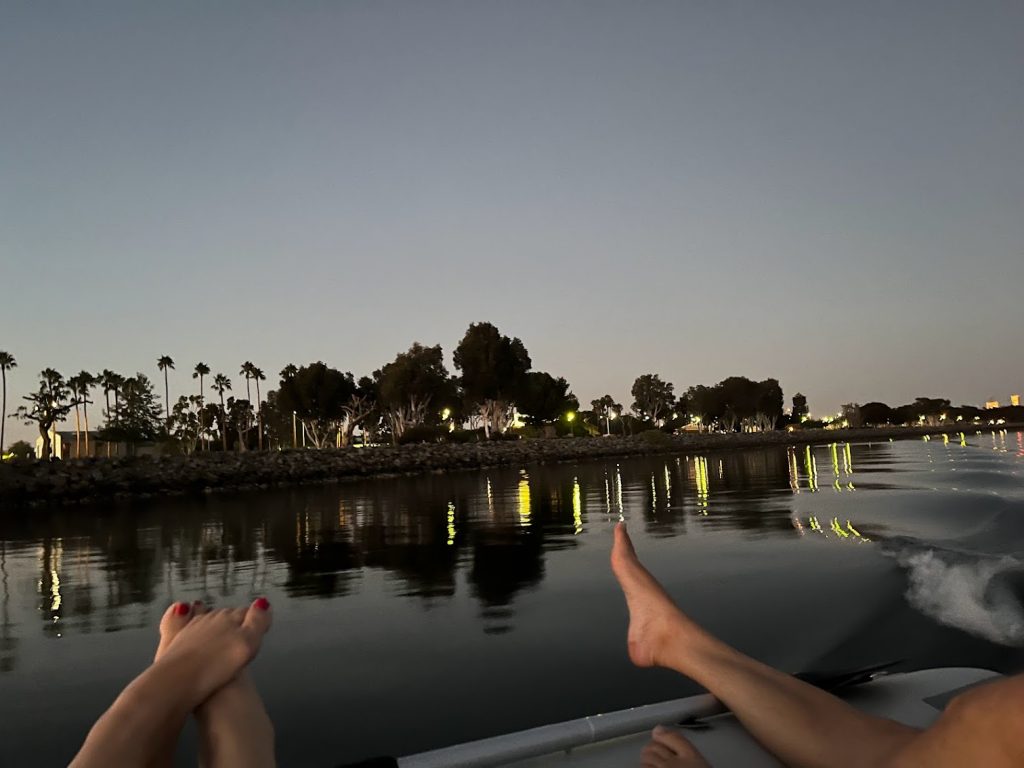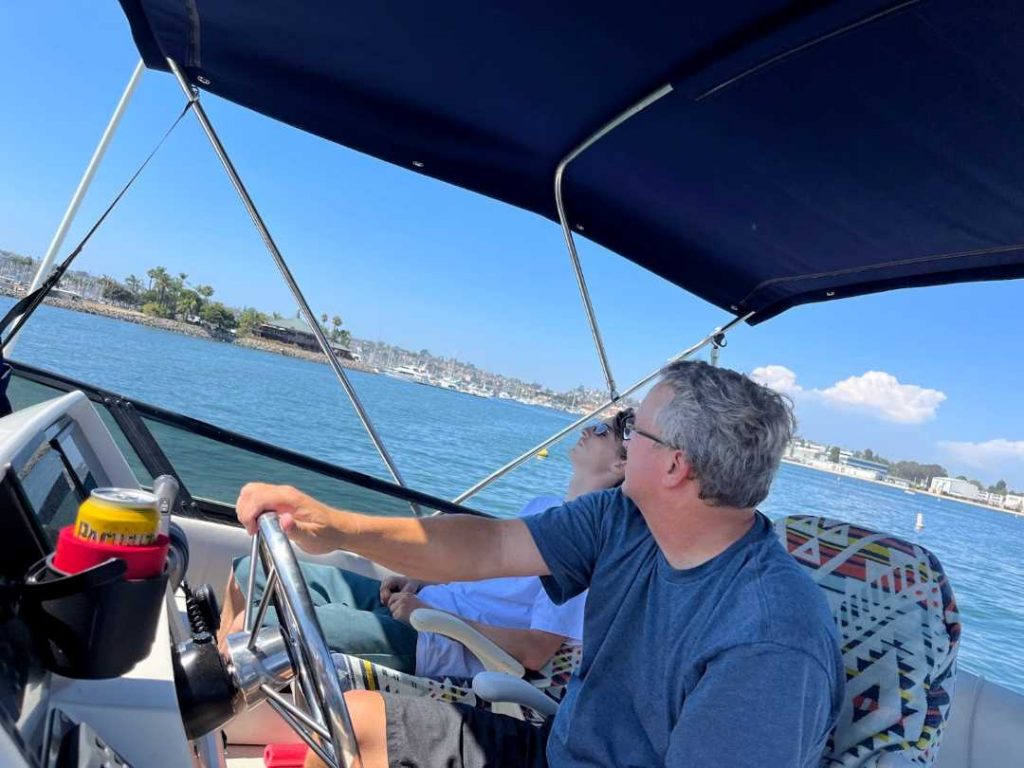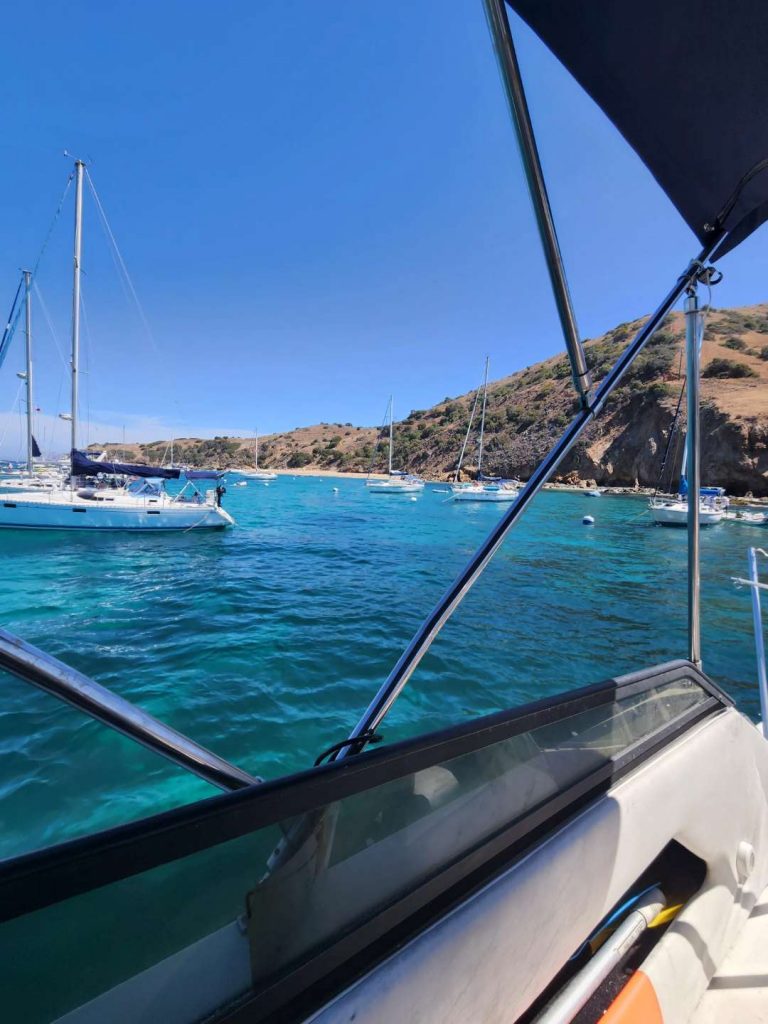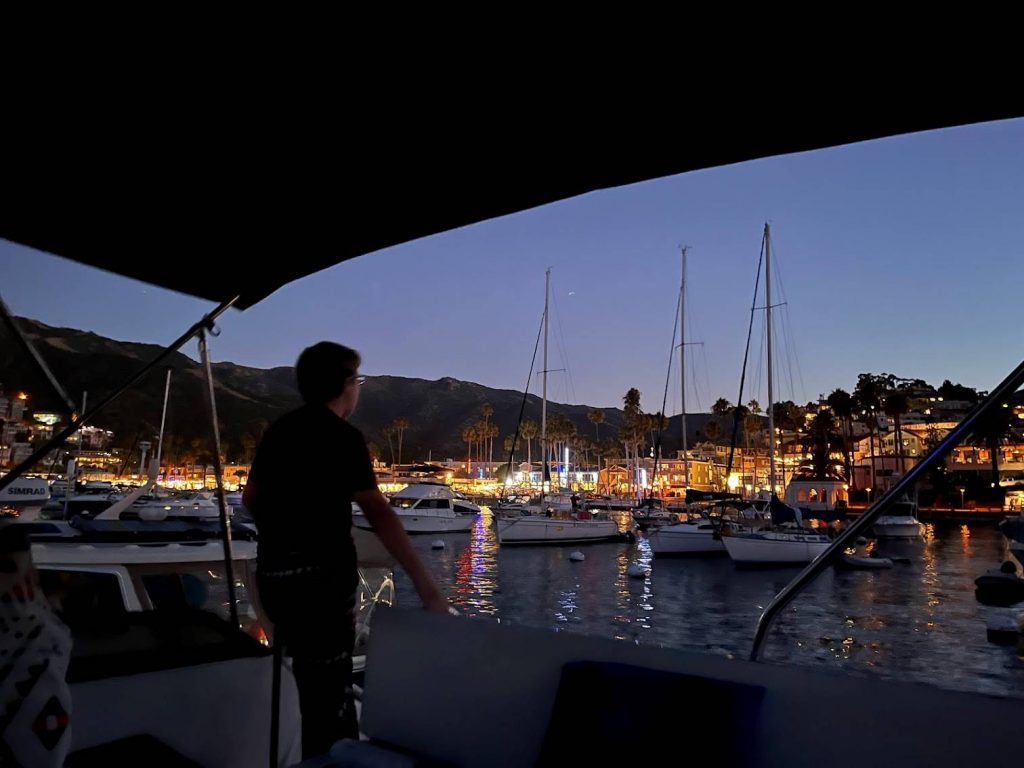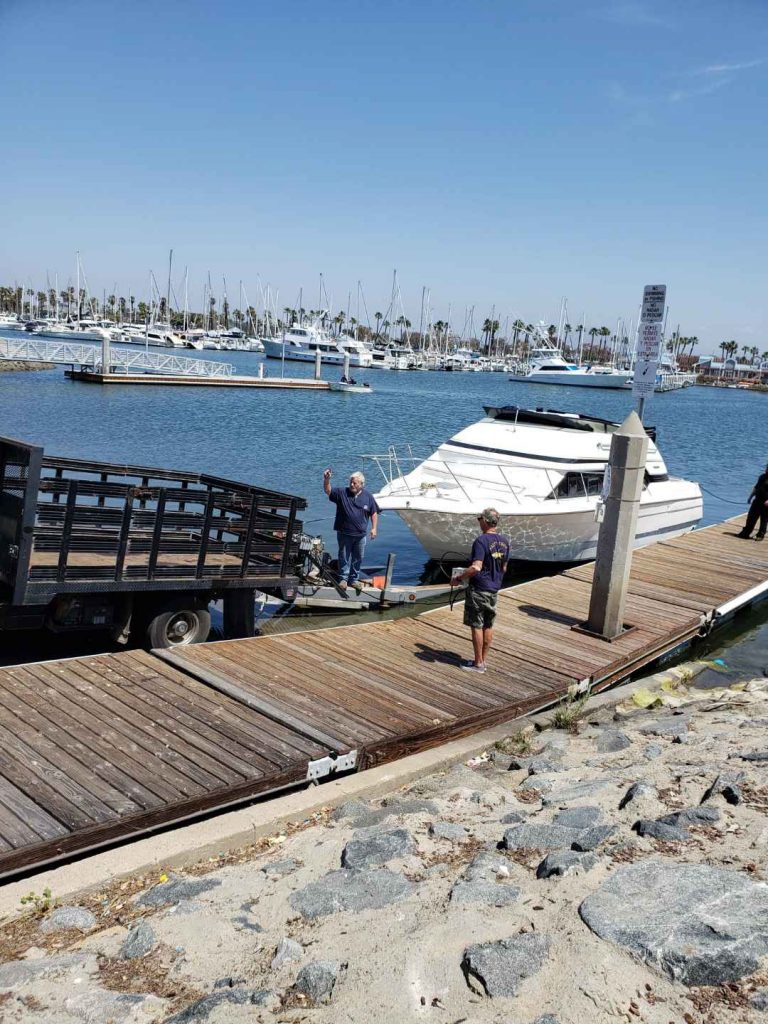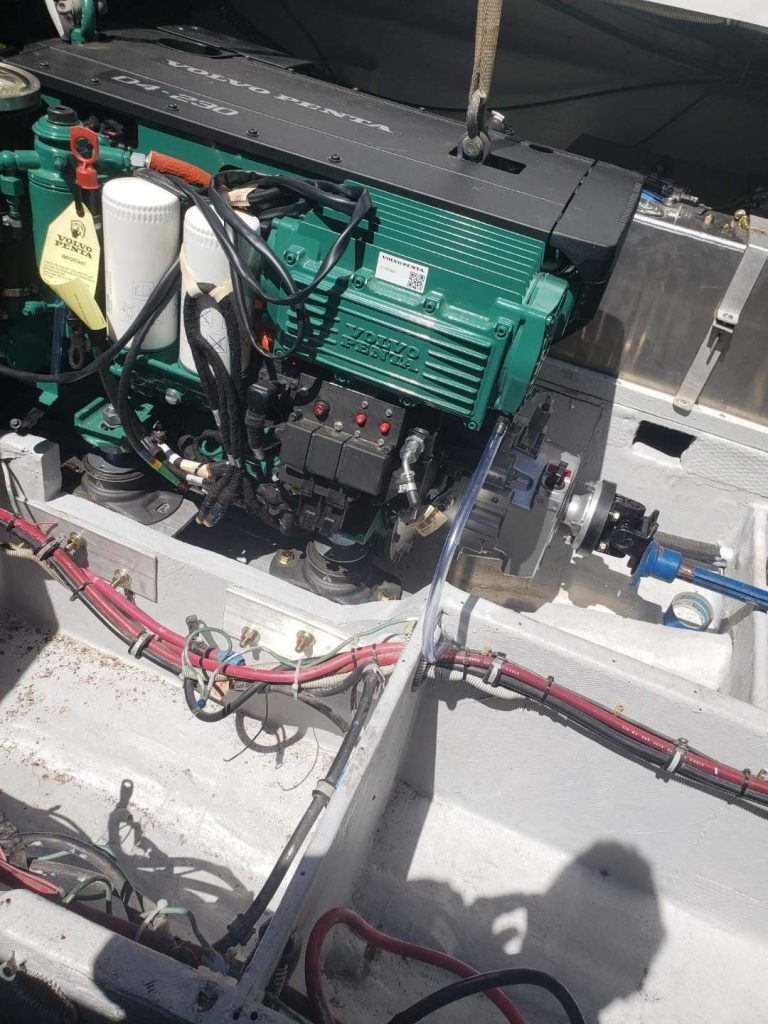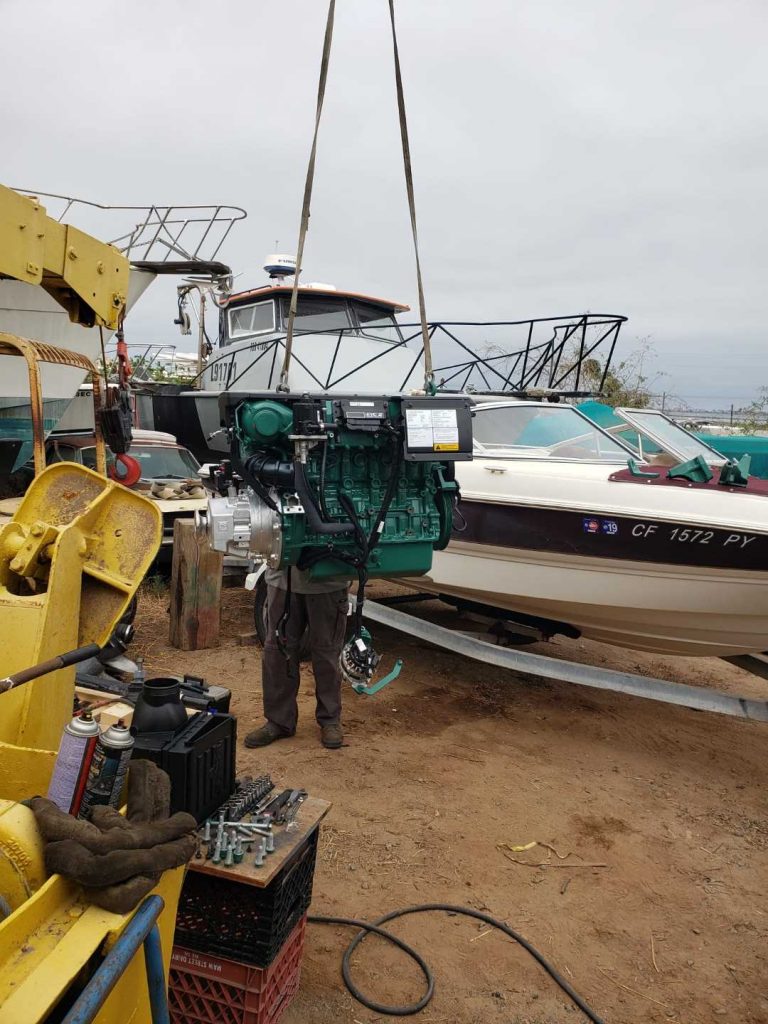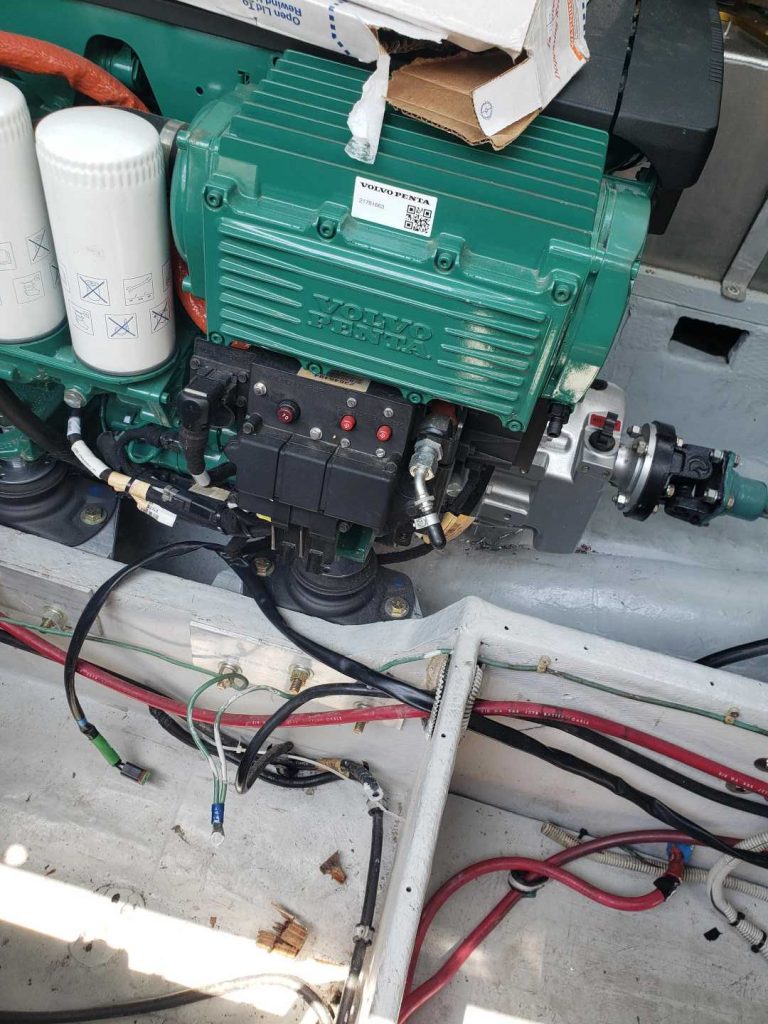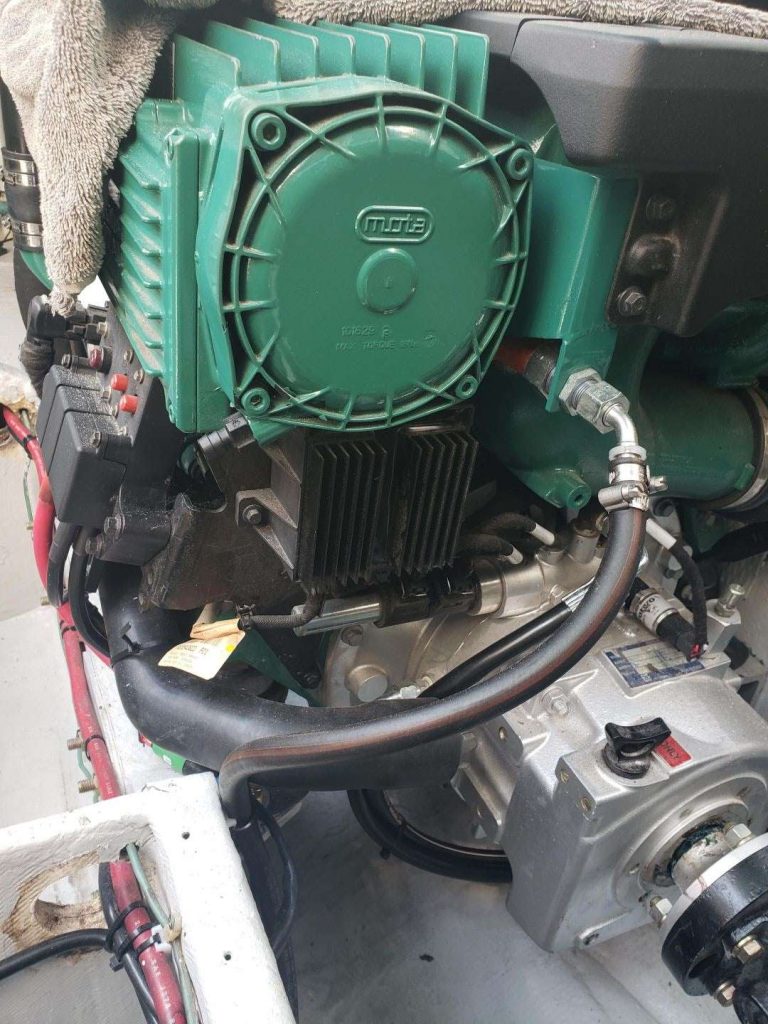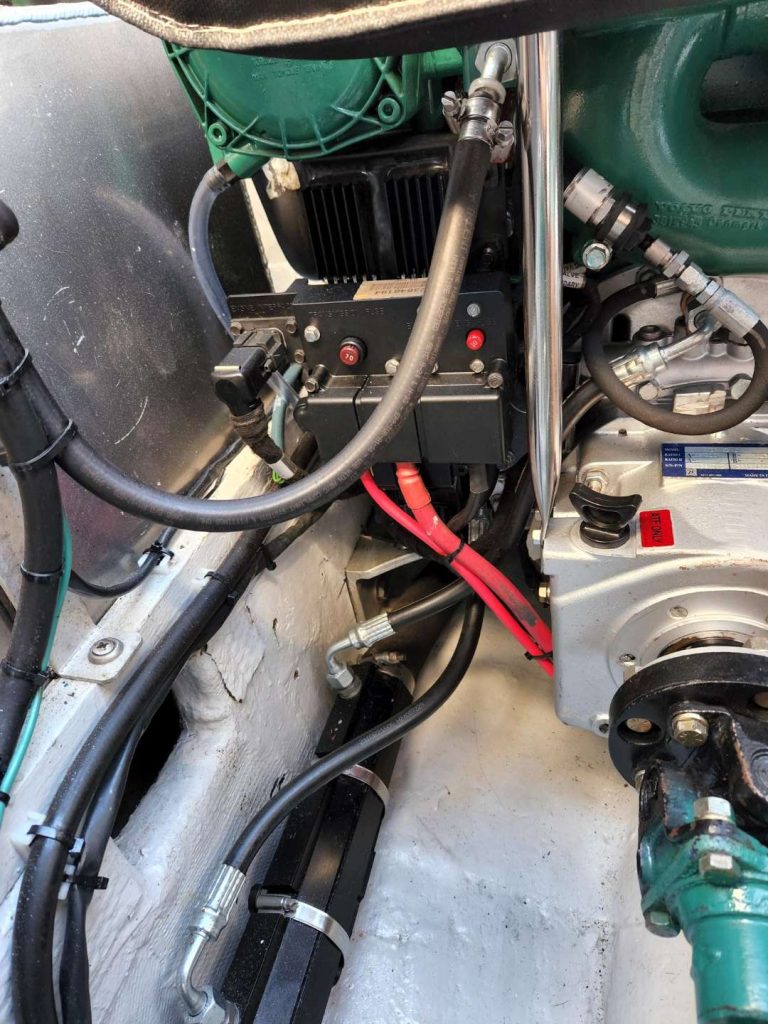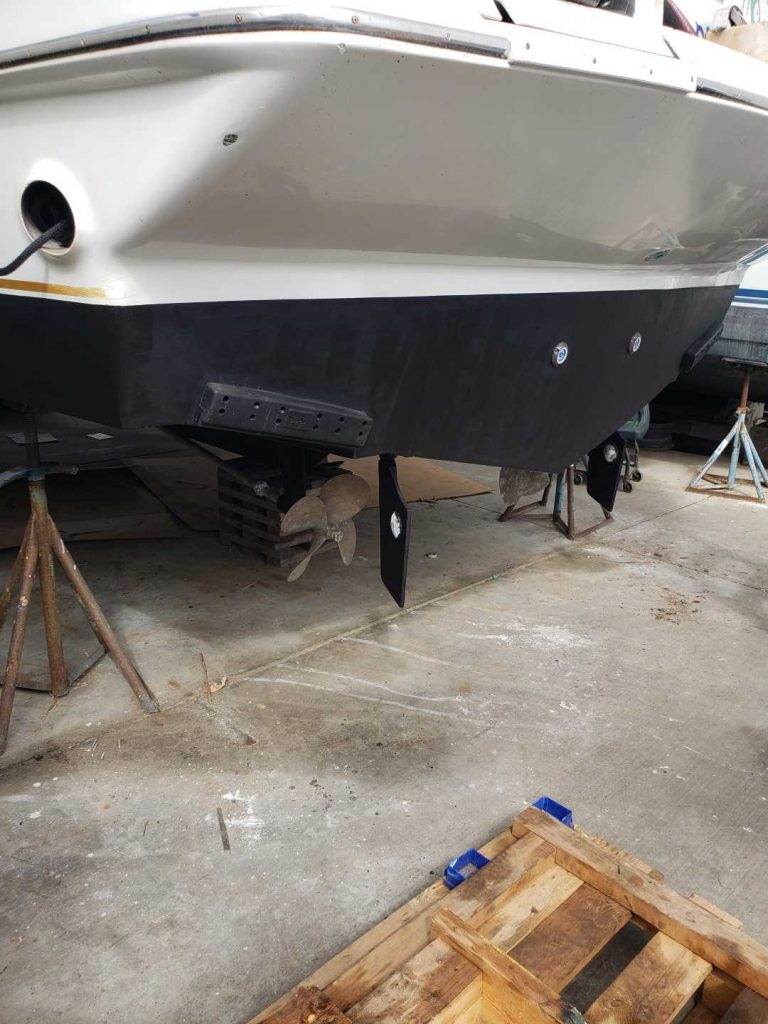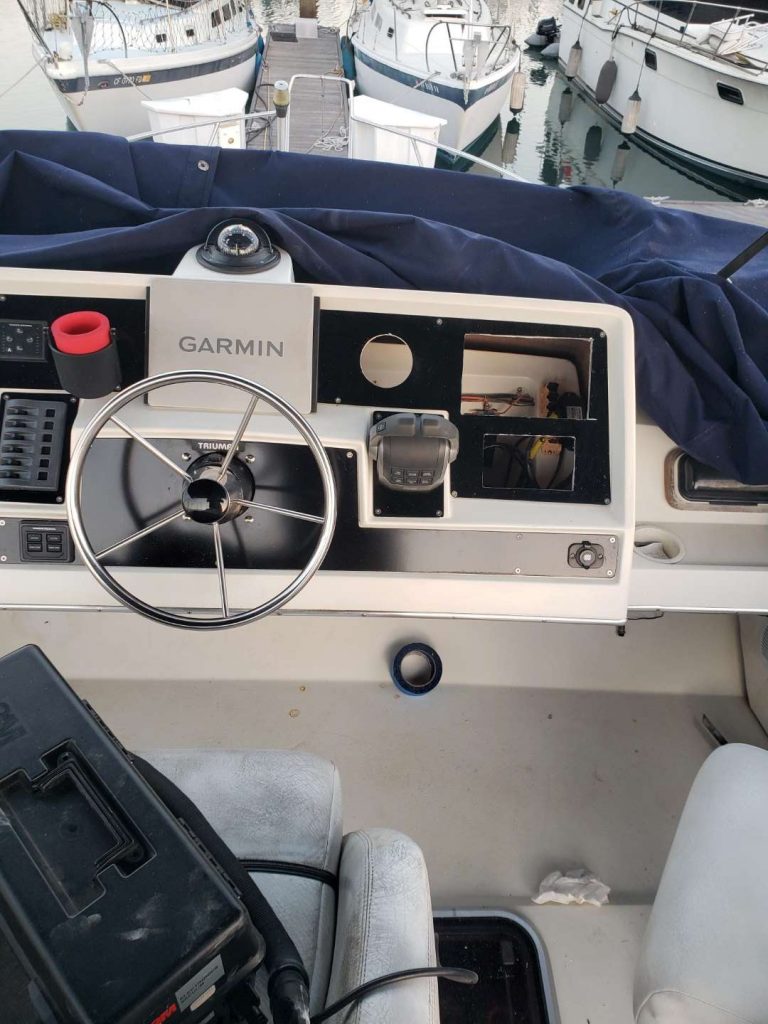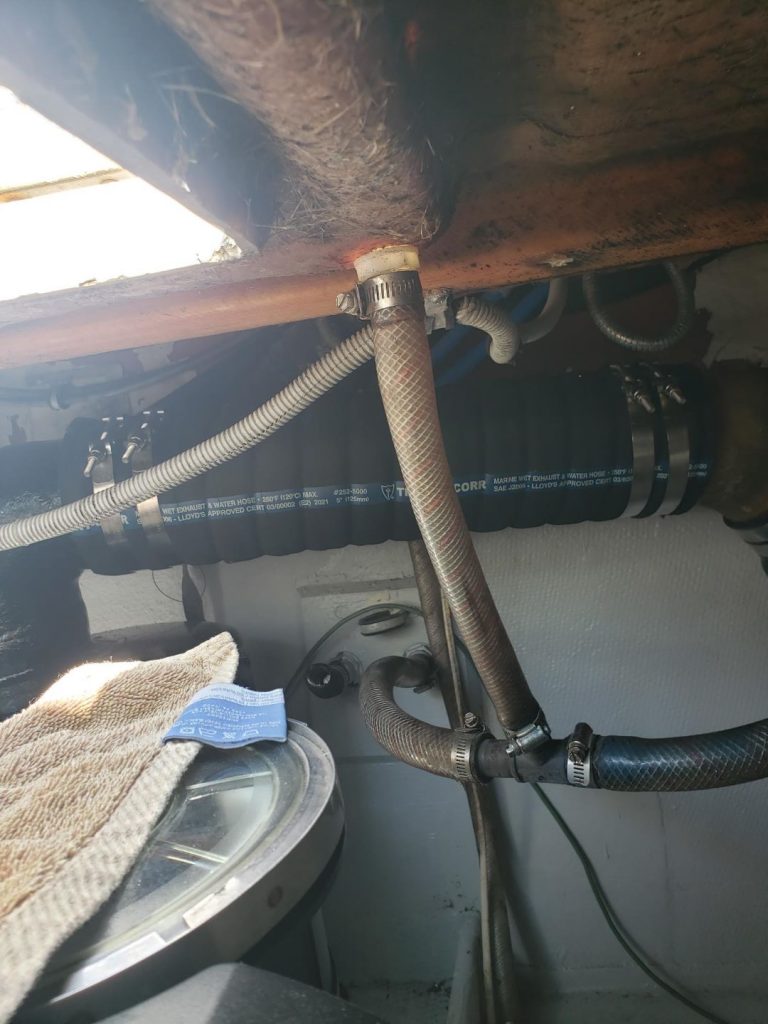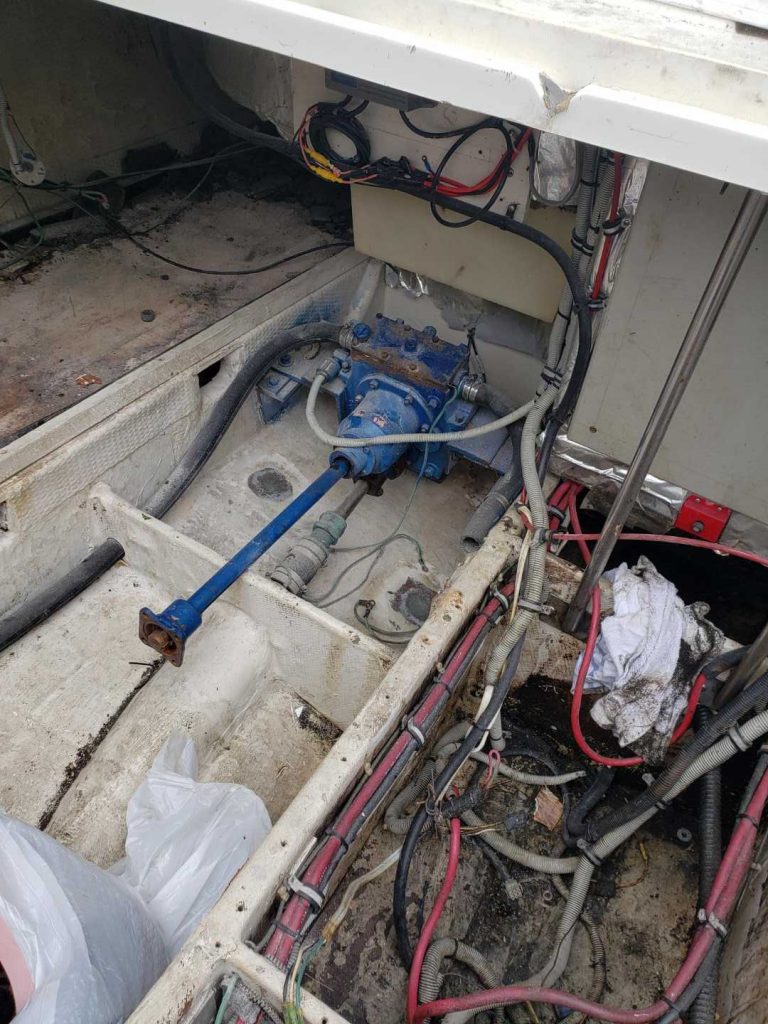Part II: My Experience Re-powering
Matching engines to a planing boat at 32-36 feet
We were shopping for a boat between 32-36 feet. This four-foot jump in boat size represents the transition range for when a boat should be switching from gas engines to diesel engines. The bigger heavier boat will need the torque available at lower RPMs so the boat can also be outfitted with a larger prop.
The larger prop will give that extra oomph when a headwind develops with rough sea conditions. That umph will also happen at a lower and more fuel-efficient RPM with the diesel. The gas engine will need to run at high RPMs with a smaller prop during rough sea conditions to get that same amount of torque, and it can burn a scary amount of fuel just to get home. The efficient diesel will help avoid running the boat dangerously low on fuel at the worst possible time. Fuel efficiency is always good, but not having fuel efficiency during rough sea conditions can quickly become a safety issue.
For boat size, I chose reference points 32, 34 and 36 feet and assigned 5,000-pound weight increments to keep things simple. I call a 32-foot boat 10,000 pounds (or 10,000-pound weight class), a 34-foot boat 15,000 pounds and a 36-foot boat 20,000 pounds or more (20,000-pound weight class). I arrived at these numbers by my own personal observations. Wow, four feet of boat length doubles the weight of a boat! Stop and understand that last sentence again because it is key to understanding this entire guide.
Obviously, there is a weight difference between something like a Carver hull and a Wellcraft hull. The older boats were also built heavier than the newer boats. My numbers on guessing a boat weight may not be perfect but they are simple enough for anyone to understand power requirements. When I hear 32 feet, I now immediately think 10,000 pounds. If that 32-foot boat is over 10,000 pounds, then I know it is a heavy boat that may need bigger engines than most other 32-foot boats. The following is my idea of what engines should be powering each of the three classes of boats 32, 34, and 36 feet.
The 32-foot (10,000-pound class) boat can easily be powered with a pair of outboard gas engines or inboard diesel engines. I did not want gas inboard engines for my own personal reasons, but I do like gas outboard engines. I did not want sterndrives drives because I feel sterndrives have too much hardware in the water.
I was looking at the 1990s inboard gas 32-foot boats with the intention of removing the gas inboard engines and having an aluminum transom extension fabricated for mounting a pair of outboard engines. If I did choose to repower a 32-foot boat with inboard diesels, then the lighter weight engines like the Yanmar 4LV and the Volvo D3 would be two diesel engines to look at.
36-foot (20,000 pound) planing boats are twice the weight of a 32-foot boat. If the boat was powered with two gas engines, then it would need to be constantly running inefficiently at very high RPMs to get the boat on a plane if it will plane at all. Therefore, outboards would not work on a 20,000-pound boat unless a third or fourth engine was added. This boat really needs the torque from a pair of 6-cylinder diesels to get the boat on a plane easily and push into a headwind. Sometimes a real heavy 32-foot boat can be in the 36-foot class because the boat builder or designer made a decision to build an extremely heavy boat. For the 36-foot class there is a nice selection of 6-cylinder diesels to choose from.
We can see that 32-foot boats and 36-foot boats are completely different boats because one weighs twice what the other weighs. The 32-foot boat is light weight, it can take diesels or outboard motors, it is responsive, tends to be faster, and it is a lot of fun to operate and tow people with. However, it does get pushed around by the sea conditions off the coast of California which causes passenger fatigue. Multi-day trips are tiring on the smaller boat. The 36-foot boat is a beast that has a much higher degree of comfort than the 32-foot boat. It is less fatiguing while underway and while sitting at anchor, but some of the smaller boat excitement and fun is lost in order to gain that heavy boat comfort, enjoyment, and extra amenities.
My sweet spot was 34 feet and 15,000 pounds. The 34-foot boat is heavy enough to push through the chop at a comfort level I am okay with for lower fatigue on the longer passages. We also wanted to stay somewhat light without the baggage of a 36-foot boat because smaller boats are always more fun than bigger boats in my opinion.
Two outboard motors would be working pretty hard to get a 15,000-pound planing boat to perform. This is the transition point of needing to add a third outboard or go diesel. Since I did not feel comfortable with three outboard engines, diesel engines became the choice. At 15,700 pounds, the pad on Plankton’s Wellcraft hull is able to support the heavier, medium displacement four-cylinder Volvo D4.
Note: I made up the term “medium displacement”. I reserve the term “heavy displacement” for the big commercial diesel engines that run around 1500 RPMs and move a boat with a displacement hull.
Note (after I wrote this): Engine products are changing fast. 350 horsepower was pretty much the biggest gas outboard out there when I started my research. By the time I was finished repowering Plankton and finishing this guide, the outboard market has completely changed. Yamaha now makes a 450-horsepower outboard and there is a Verado 12-cylinder that can make 600 horsepower. The transition point from having to change from gas to diesel is not as clear as it was earlier.
Recommended reading. “Power Options: Gas-vs-Diesel Part II” from David Pascoe is a must-read if you are planning on repowering a 32–36-foot boat. In this article, Pascoe states when a boat reaches about 35-38 feet and 16,000 pounds the gas engine can no longer push the boat efficiently. Plankton is 15,700 pounds and on that threshold. To me that means Plankton won’t have efficiency with gas engines if the seas get rough.
Before buying a boat to repower. Why not choose an engine you like, then buy a boat to pair with that engine? Consider that most of the value of an older boat repowered with brand new diesels will be in the engines and not the boat hull. It only makes sense to already know what engines you plan to use before buying the boat. You may realize the boat hull being considered should really weigh 2,000 pounds more or 2,000 pounds less so your preferred engine block will be in the middle of its horsepower range and the boat pad is displacing what it needs to displace for the engine weight.
A diesel option was offered for my boat when it was new, but the engines were six-cylinder engines that were too heavy for the boat. The best option in 1991 for this 15,700-pound boat was not the diesel, but the 454 Crusader gas engines that it got. 30 years later, there are two highly respected four-cylinder diesel engines for 32 to 34-foot planing boats. They are the Volvo D4 and the Yanmar 4LV. Because of engine weight and the boat hull pad displacement needed to support that weight, the Volvo D4 might be a better choice when replacing a heavy Crusader 454 gas engine with heat exchangers. The Yanmar 4LV might be the better choice when replacing a 454-gas engine block from any other manufacturer.
Making an engine choice for Plankton
I ruled out Caterpillar and Cummins because their smallest engines (6-cylinder) were too heavy for Plankton. Beta and Westerbeke engines were too small. Perkins and John Deere four-cylinder engines seemed to be very heavy displacement engines running at lower RPMs. Volvo and Yanmar seemed to be my only real choices for a well-known and well-respected four-cylinder higher RPM engine in Plankton’s weight range.
Note (after I wrote this): What I just stated about six-cylinder weight is not accurate anymore. The six-cylinder planing boat engines from Cummins are now much lighter than their older six-cylinder engines. The weight of the Cummins would now be a good match for Plankton but the torque would be too high for Plankton’s drivetrain. Keep in mind that everything is changing fast. You should be checking each manufacturers website to see what their current products are along with their specs.
Engine selection guide before dealer torque calculations were run: Torque (step 1) and Weight (step 2) – I could not confirm the exact torque and weight for the Crusaders so I had to guess. The 350hp big block 454 cubic inch Crusaders seem to have 430 ft-lb of torque (I think), so I needed a diesel with 430 ft-lb of torque. The weight of a Crusader 454 big block with heat exchangers is probably 1150 pounds, (I think). The plan was to replace the Crusaders with diesels of the same weight to avoid any ballast issues.
This chart shows model numbers and horsepower of the engines but we should really only focus on the torque and the weight.
Engine HP Torque Weight Displacement
Crusader 454gas 350hp 580 nm, 430 ft-lb 1150lbs NA
Volvo D3-220 220hp not on spec sheet 573lbs 2.4L, 179 cu-in
Volvo D4-230 230hp 590 nm, 435 ft-lb 1246lbs 3.7L, 225 cu-in
Yanmar4LV-250 250hp 580 nm, 425 ft-lb 736lbs 2.75L, 168 cu-in
Yanmar8LV-320 320hp 740 nm, 540 ft-lb 959lbs 4.46L, 272 cu-in
Yanmar: Yanmar got ruled out for no other reason than Plankton was between two engine block sizes in the Yanmar lineup. The 4LV-250 (four-cylinder) is the highest horsepower on the 4LV block. This engine will get the job done, but I am not comfortable with being on the highest horsepower on any block just to get Plankton to reach its minimum required torque for performance. It’s a nice engine block, but I wanted a little bit bigger engine for longevity. It is my personal judgment that the 4LV will be working too hard for this 15,700-pound boat. Some people may argue my judgment, but those people are not spending my money.
The 8LV (eight-cylinder) engine has about 540 ft-lb of torque. The engine weight could be worked with and it was nice to dream about the extra power. However, following my own guide, the 8LV torque would be too high for Plankton’s drive train and would guarantee a v-drive and prop shaft replacement. There seems to be a small gap between the 4LV and 8LV engine blocks where Yanmar doesn’t have a product. Plankton found that gap.
Volvo: The Volvo D3 (5-cylinder) engine block, like the Yanmar 4LV, was ruled out for Plankton for all the same reasons. It is also an aluminum block and I am not sure how I feel about an aluminum block on a diesel. However, at 573 pounds, this engine clearly offers a lightweight solution for those who want or need it.
The D4 (four-cylinder) engine block series seemed to be the perfect fit for Plankton. I could get about the same torque as the Crusaders and the weight is about 100 pounds heavier per engine. I can work with that. The D4-230 is in the middle range of horsepower for the D4 block, making me comfortable with my choice for engine longevity. The dealer calculations also agreed that the D4-230hp model was the correct horsepower model on the D4 block for my boat.
My other random opinions on engines
CAN bus integration. Plankton has two new MFD displays at the helm. One was intended for navigation electronics (chart plotter, fish finder, radar, autopilot, VHF AIS) and the other was intended for the exclusive display of engine, transmission, and fuel tank monitoring. I planned for two displays so I could have two separate CAN busses and there would be less of a chance of screwing up the engine computers. The engine shop and the electronics installer thought I was crazy so I got talked into integrating everything together on one common CAN bus.
After the navigation electronics guy was finished integrating his stuff on the common CAN bus, the engines did not work anymore. I then had to pay the Volvo diesel engine mechanics to come back to the boat, disconnect navigation instrumentation off the common CAN bus and reload software on the corrupted engine computers. I then had the navigation electronics guy come back in to modify his CAN bus to be completely independent of the engine CAN bus like I wanted to do in the first place.
Just because all the electronics can be tied together does not mean they should be. Plankton now has two CAN busses and each CAN bus has its own Garmin display. There are two more reasons for this configuration. I want engine monitoring to have its own display with no other applications in front of it. The other reason is that a single common CAN bus will cause a future maintenance issue when components become obsolete at different times due to their applications. Here is my reasoning:
The navigation CAN bus will be constantly evolving. New technology navigation components will be coming out every year. The new components will be plugged into the CAN bus and the display on that bus needs to be able to support all of the new components. Eventually the display will become obsolete and not be able to keep up with the technology of the newly added navigation components and it will need to be replaced. If the display is not tied to the engines, then it can be any “off the shelf” display like Raymarine, Simrad, Garmin, etc. That means all options are open when upgrading the navigation display in the future. That will probably happen within about 10 years.
The engine CAN bus and its display should be good for 20 years or until the display dies. None of the technology on the engine CAN bus will change for the remaining life of the boat. I did not want to involve a diesel engine mechanic in the future when a new navigation component is added to a common CAN bus and the aging engine display does not play well with a newly added navigation component. Also, there is the human factor where the navigation electronics installer may not be following best practices on his installation and introduce problems. Ask me how I know. I do know the Volvo mechanics receive training from Volvo.
The Volvo programmed Garmin engine display is not an “off the shelf” component. This display will need to be purchased from a Volvo engine dealer and it needs to be installed and supported by a diesel engine mechanic for its entire life. Volvo buys the display from Garmin, but then Volvo reprograms it. That means it is very expensive and Garmin will no longer provide technical support in the future if any new navigation components don’t integrate with the display. Volvo will take the responsibility of supporting the Garmin display via a Volvo diesel engine mechanic and a bill the boat owner at a diesel engine mechanic rate.
Charging the house bank from the alternators. The new (non-engine) smart computers and controllers can cause frustration with compatibility. All of the components are so smart they can outsmart each other. The new smart alternators on the new engines may need a smart 12v to 12v battery charger to charge the house bank instead of using a simple charging diode. Each lithium house battery has a smart BMS (Battery Management System) that can outsmart other smart components. The house bank battery monitor may not be able to see a charge coming from the alternators because the charge did not go through the smart inverter. Integrating all these smart components can easily leave the dumbass boat owner with an empty wallet. Ask me how I know.
Two computer issues I had. I have experienced a computer issue twice now because of other people not understanding the red battery switches under the companionway steps.
Plankton has two red battery selector switches under the companion way steps that enable the starboard and port engine starting batteries. Both switches are in the off position when the boat is not in use. The switches are turned on when I get ready to use the engines. This is the first step of the engine starting process. When a red battery selector switch goes on, power from that starting battery applies power to that engine and the engine computer starts to boot up.
Step two is to press the (port and starboard) ignition switch buttons on the helm pushbutton starting panel. The ignition switch on the helm dash enables the engine computer to integrate on to the CAN bus and talk to the Garmin display, HCU, transmissions, alternators, and fuel tank sending units. This is not immediate. Bootup and communication links are being made and it can take about 30 second or so. Turning the red battery switch on first and pressing ignition button second is a two-step process to bring the engines on line. The third and final step is to press the start button on each engine to crank the engine.
Shutting the engines down is the same process, but in reverse. The engine is shut down via the start button, then the ignition button is pressed, then it is best to wait about 30 seconds for boot down before flipping off the red battery selector switch under the companionway steps.
Many contractors who are going out to service boats are just starting to see computerized diesel engines for the first time. They have not developed a set of best practices when working on a boat with electronic engines. I found that I need to help with establishing these best practices by reviewing the engine startup and shutdown process with a contractor before they perform any electrical work on the boat. If I don’t, then it will cost me.
The first issue I had was with the helm electronics installer who for some reason was indiscriminately flipping the red starting battery switch on and off which was basically starting the engine computer and shutting it off in the middle of the boot up, and then turning it back on and doing it again and again. Aargh!
He was on that switch because we were temporarily borrowing power from one of the engines starting batteries to power the bridge until the other electrician could make it over to reroute the battery switches to my preferred configuration and hook up the house bank. The helm electronics installer still should not have been flipping that switch indiscriminately. The Volvo mechanics had to come in after the electronics guy was done and reload software on the engines. That was when we decided to go back to my original idea and isolate the two CAN busses.
The second issue was when I was working with my primary electrician to troubleshoot the lithium house bank Victron battery monitor not updating correctly when the engine alternators were charging the lithium house bank via the Sterling chargers. I was assisting the electrician on the bridge to start and stop the engines as needed. At one point both engines were stopped, but the electrician was not aware the ignition buttons up on the bridge were still on. Then he then reached over and flipped off a red battery selector switch so he could take another measurement. If I had made him aware of there being two parts to the engine boot up process, then this may not have happened.
The electrician killed power to that computer while the ignition circuitry was still booted up on the CAN bus. The next time I went to start the engines I had to try twice to get the ignition buttons to activate. On the second try, the ignitions came on begrudgingly and communicated with the Garmin display. Sort of. The Garmin display did not have my customized gauge view layouts that I configured before. The option to get the specific view layout that I had was no longer available. Aargh!
A new diesel is different than an old diesel. A big change is the common rail fuel injection that is using a very high pressure to atomize the fuel as it sprays through the injectors to get a more complete burn. The computer will control a pre injection, injection, and post injection on each cycle of the cylinder to get a much higher efficiency which translates to using considerably less fuel and of course, much less emissions. Repowering a boat is not just about replacing a tired engine anymore. It is a government mandated technology upgrade for less emissions. The side effect is a more reliable, computer controlled and efficient engine.
The computers will instruct the injection instead of the operator manually dumping fuel into the cylinders. The computers have the boat operator’s back and should inform him early on if any of the sensors detect an issue and will often limit the performance of the engine to prevent damage. A computer that monitors the engines is a big deal for lower displacement high RPM engines that can suffer catastrophic failures mor quickly than an old school diesel.
New supersized outboard engines. Using a pair of the new supersized outboard engines or adding a third outboard is a tricky concept to play with. My main concerns are the boat pad being able to support the extra weight, and with the extra fuel capacity that would be needed to support those engines especially when the sea conditions get rough and gas fuel efficiency goes down. There is a point when an engine configuration change to an old boat becomes so drastic that a new boat would be a better solution. I personally think that a supersized outboard engine configuration or configuring with more than two outboards should be left to a boat designer who is designing a new boat from scratch.
Sterndrives and outboards. Sterndrives and outboards have the advantage of having the drivetrain designed and manufactured at the factory and attached to the engine as one unit. Most of this guide becomes unnecessary with this type of modular engine and drivetrain package. Outboards have the additional advantage of being able to tilt the drivetrain out of the water when the boat is at the slip.
A sterndrive however cannot be tilted out of the water so there is a lot of hardware always in the water and the seal between the sterndrive and the boat transom is a rubber bellows. This may not be a problem for a commercial operator who will wear out his engine and sterndrive in less than 10 years. That boat would then get a replacement engine and sterndrive package and the bellows replaced all at the same time. A stern drive for a recreational boat owner is an entirely different story.
WOT on a sea trial. Plankton’s brand-new Volvo D4 engines are rated to run at Wide Out Throttle for a 10% duty cycle. That means the engines can be run at max RPM for 6 minutes during an hour of use. I will sometimes use that full duty cycle for one reason or another. If someone was selling me a boat with 30-year-old diesel engines, and they were telling me their engines were still being broken in, then I would ask them to show me the published WOT duty cycle rating for that engine.
I would then ask for a sea trial to run the engines at WOT continuously for the published WOT duty cycle before I paid them for their claim of having engines in top condition. I would be closely monitoring the temperature gauges during that duty cycle (probably 6 minutes on a one-hour sea trial), and the next ten minutes afterwards to see how well the owner maintained their cooling system. I would open the engine compartment a few minutes after the WOT duty cycle and look for surprises.
Choosing an engine dealer for Plankton
First off, be kind to your engine dealer throughout the process. As I mentioned earlier, you will most likely have at least one moment of regret while repowering a boat as you work through the process. The engine dealer has to deal with many of their clients going through a regret process. It is not the shop’s fault that the boat needed more work than the boat owner expected. The shop is just doing what needs to be done. The dealer will probably also be doing the engine maintenance work on the boat going forward for as long as you own the boat.
The first Volvo dealer I spoke with was pushing the D3 series because he said it was made to be the direct replacement to the 454 gas engines. The direct replacement approach is the same thing as skipping steps 1-6 in this guide. I believe his thing was a standard off the shelf job to keep things simple and straightforward. That was good because we would have been working out of a boat yard and I would be paying for lay days and fork lift or crane rental. I thought that was a great idea until I did more research. Direct replacement does not mean correct engine sizing.
If I went with the D3, then I would have lost 1200 pounds of engine ballast off the back of the boat. The stern may have become over buoyant and I would probably have to shift or add ballast just to get the deck and scuppers to drain correctly. The light weight D3-230 engine would also be on the maximum horsepower for that block and would probably be working too hard for Plankton’s weight. It could have meant a short engine life. Narrowly avoiding that mistake served as my motivation to do more research and start writing this guide. The person paying over $100,000 to repower their boat should not be completely dependent on the dealer to make an engine choice for them.
The second dealer came through reference (Cogswell Marine, Chula Vista). Pete wanted to know about my boat before he would even talk to me about engines. He also has a full rebuild and fabrication shop so things like engine mounts, engine modifications, exhaust bends, custom brackets and countless other things could be fabricated or modified in house. The first dealer had a good reputation in the boat yard, but Cogswell had more resources because they were repowering boats at their shop. They also build and race cars so they have a real interest in overall boat performance when they plan an engine replacement.
Doing the job at a marina boat yard vs bringing the boat to an engine shop is an interesting comparison. Some engine shops have a trailer with hydraulic lifting pads for transporting big boats to their shop, but their trailer may not be able to carry a 36-foot boat. A 36-foot boat may have to stay at a boatyard and the engine dealer shop will have to travel to the boat yard and they will probably charge travel time. You might be able to contract a boat mover to transport a bigger boat to an engine shop.
Repowering at a boat yard can be faster because the boat yard has more boat repair resources for fiberglass, changing through hull fittings, bilge painting, building a new helm dash or whatever. A 30-year-old boat will need a lot of hull improvements while repowering to a new engine configuration. However, a boat yard engine mechanic may have limited resources to build an exhaust manifold or relocate engine components. Depending on the boat yard, engine modifications may not happen at all. There will also be a lay day fee at the boat yard.
An engine shop has the machinery and other resources right there to do any kind of engine modification or fabrication during the installation with lay days and crane use probably being free. Engine components can be more easily relocated so they are more serviceable in the future. However, the engine shop’s boat hull improvement resources are not as readily available compared to a boat yard. Actual boat hull improvements can take longer or may not happen at all depending on the shop. Finding the balance should be a consideration when choosing who does the work.
Cost and additional expenses over the estimate
Preventative maintenance on the boat needs to be done in proportion to the overall condition of the engines. Most 30-year-old boats are maintained in proportion to having 30-year-old engines. The standards of maintenance on the boat now needs to match the condition of the new engines. Plankton was a very poorly maintained 30-year-old boat. Preparing Plankton for new engines was not too different than stripping the aft 1/3 of the boat down to the fiberglass shell and rebuilding it. If reliable engines are installed in an unreliable boat, then the boat would still be an unreliable boat.
The brand-new diesel engines should be giving another 30 years of life to the boat and that won’t happen if the engine compartment is not as good as the engines themselves. The cost of repowering Plankton was almost 80% over the engine replacement estimate because there was a lot of deferred maintenance and almost no upgrades done to the boat before I bought it. Anyone should plan on 60% to 80% over the engine replacement estimate (when going from gas to diesel) depending on how well the boat was maintained and upgraded over the past 30 years.
It is too much of a wild card for the engine dealer to visit a boat and give an estimate beforehand. Plankton’s original engine replacement estimate without seeing the boat was around $85,000. That was to purchase and install two Volvo D4-230 engines, two electronic ZF transmissions with connecting kits, a 7-inch Volvo programmed Garmin display, a helm control unit and connect everything together. The job ended up being completed for $150,000 because of needing new tanks, props, hoses, bilge paint, steering ram etc. An $8,500 tax extracted by the California general fund was not on the original estimate.
The labor on the dealer’s original invoice to change just one engine was $5,000. That is just for an engine swap. It assumes things like the rubber hoses, engine mounts and exhaust manifolds are being reused and almost no changes will be done. The shop assumed I was bringing in a boat that was well maintained with no deferred maintenance. The estimate was basically a “like for like” engine swap.
Every boat is a unique situation and the dealer needs some kind of starting place in order to give an estimate for new engines. I am assuming most dealers make the same “like for like” assumption so they can quickly send out an estimate which will scare most prospective engine buyers away anyhow. In the end, the estimate did not really seem to matter. The dealer did the work that needed to be done and charged me the going rate to do it.
For example, I assumed new engine mounting brackets were covered in the original invoice. The shop assumed we would be using the old engine mounting brackets. Cha-ching. I assumed rubber cushion engine mounting pads (between brackets and engines) came with the engines. They did not, cha-ching. My engines did not sit on top of the stringers. They went several inches down in between the stringers, and the stringers on Plankton were somehow spaced 1.5 inches narrower than standard. The holes on the engine mounting brackets had to be slotted to fit the engines between the stringers. Cha-ching. The stringers also needed cuts and the cuts needed fiberglass work afterwards. Cha-ching. That just hits the tip of the iceberg. I have made a list of things to discuss with the dealer while guessing the extra costs over the estimate. They are:
Haul out, lay days, use of cranes for lifting engines and tanks, bottom paint, remove gas engines, engine mounts, remove any other stuff (for me it was the generator and all its support equipment), remove all old wire and cable runs from the helm to the engine compartment, remove old helm gauges and controls, replace the helm gauge board with a blank board, mount new electronics in the blank dash board, removal and reinstalling of any cabinetry that the control cables pass through (or for any reason), clean and repaint the engine compartment, inspect and polish fuel tanks, replace gas filling ports to say diesel, replace fuel tank sending units, pre-filter fuel-water separators, replace the old rubber hoses, service and repaint v-drives, starting battery resizing, bigger seawater strainers, fiberglass work after busting out the old smaller through hull fittings and possibly exhaust ports, larger engine cooling thru-hull intakes, fabricate exhaust manifolds, replace or repitch the props, and sea trial. Also, keep a budget for new fuel tanks.
Some engine components needed to be relocated on Plankton’s brand-new engines. Cha-ching. It is a good idea to ask your shop if they will even do engine modifications to the new engines so they will be more serviceable.
Assume the new engines will be installed exactly where the old ones were. Look at internet pictures of the new engines and compare them to the existing old engines on both sides of each engine. Compare where the new engine may be pushed up next to a fuel tank, bulk head, stringer or whatever. Then look to see if any serviceable engine components on the new engine will be unreachable. Ask the shop if they were planning on relocating those components. For my shop, relocating engine components is an expected part of an installation but it is not included in the estimate.
I added some extra work to the repower which helped drive up my bill from 60% over the estimate to 80% over the estimate: Replace the fuel tanks, replace the steering ram because it was 30 years old and leaking, upgrade trim tabs to interceptors (trim tabs were not working), all of the thru-hull fittings on the entire boat were removed, holes were glassed over and only four were reinstalled, add containment rings for the jack shafts, build custom raised brackets for pre filter fuel-water separators, build a longer route for the starboard engine exhaust manifold with custom sewn lagging, add temperature sensors on both exhaust manifolds where the hot water combines with hot exhaust, and add a raised aluminum diamond plate deck between the two engines.
You will be doing some work
I thought I could just drop the boat off and write a check and get a nice boat back. I found out it does not work that way. The boat owner will need to do the crap work if nobody else can be found to do it. For me that meant scrubbing down the very dirty engine compartment and removing 30 years’ worth of owner installed janky wiring and plumbing for cheap gear that stopped working a long time ago. That substandard wiring can cause electrical problems elsewhere so it all needs to come out.
Countless unused and broken wire tie fasteners and old hose fasteners had to be removed before paint. I can guarantee that a lot of crap will get painted over if the boat owner does not get in there to personally remove it. Also, how do you really know the new bilge paint will have good adhesion if you did not prep the surface yourself. I got lucky and someone in the shop painted the compartment because their regular paint guy was not available. The shop mostly wanted to make sure a two-part bilge paint was being used because regular bilge paint is notorious for taking a long, long, long time to dry.
I did the scrubbing and prep. It was three full days of work for me that included understanding and making decisions on what hoses and wiring should be removed or replaced, and then removing stuff. I bought three big bags of cleaning rags, wore out six kitchen scrub brushes, used the purple degreaser, finished off with TSP and disposed of the wet rags in trash bags. After paint, I replaced the deck scupper fittings and scupper hoses and bilge pump hose leading through the engine compartment because they were all old and cracking and nobody else wanted to do it for me.
An engine shop may be willing to do some of the boat hull work, or none at all. A boat yard is geared for doing boat hull tasks, but I was at an engine shop and not at a boat yard. Most shops or boatyards will want to see insurance on any sub-contractor brought in to work on the boat. I ended up just doing the extra boat hull related work that the shop did not want to do. Labor was hard to find as long as the governor was handing out money in this covid economy.
I did get lucky and my shop was willing to do a lot of boat hull work that was not engine specific. They contracted to have a tank polisher come in. The tanks failed inspection so they ordered new tanks for me and installed them. The fuel hoses were cracking, so they replaced them while replacing the tanks. They removed all the through hull fittings and contracted to have a fiberglass person come in to fiberglass shut the holes. They removed the trim tabs and installed interceptors and installed underwater lights. They replaced the steering ram for me. They built a raised diamond plate deck between the two engines and they built a new dash panel at the helm.
Time to complete the job
There is nothing productive about this job. Every single part introduced to any boat will probably need to be modified as it goes in. The dependable, qualified people who do custom work were not on standby waiting to drop everything and work on my boat. They are always busy, but they were willing to work me into their schedule.
All of the boat’s individual infrastructure improvements and engine installation tasks were queued one at a time between other boat engine repairs, rebuilds, outdrive repairs, dyno testing, and whatever else the shop normally did to run their business. Basically, my repower was composed of many small projects. The shop worked my many small projects into their busy schedule one at a time.
The shop did not move on to the next project for my boat until the current one was completed. If there was a single delay on one project, then the rest of the boat had to wait until that issue was resolved. After any single project was finally complete, then they scheduled the next project to start at the next opening in their shop schedule. That caused me a lot of frustration when the boat just sat in the yard for months. Ironically, I will support this approach in the next section.
Some of the delays were: Their regular painter recently moved away. Three weeks were lost looking for another qualified and insured painter before I started cleaning and prepping myself. The fiberglass guy disappeared for three weeks because he was a fishing captain and the bluefin started running. New fuel tank fabrication took over two weeks. There was a faulty Volvo CAN bus harness that took three weeks to resolve. The engine mounts had too much flex and needed to be replaced with a different model. StarBoard plastic for the dash was not available and the aluminum dash took an extra two weeks to make because of…, I’m not sure. I finally snapped at that point. I think most people who repower come close to, or finally reach their breaking point because they were not prepared for how long it would take. I know I did.
Plankton’s repower took over six months out of the water and the delays came from all different directions. Covid supply chain issues did not help. That was just the time out of the water. It took five months from the time I wrote a deposit check until the engines arrived. During that time the boat was unreliable and staying at the slip in the marina. Then it took another month after the engines arrived to clear a space in the shop’s yard because of the covid economy. Then the boat came back out of the water for three weeks after the first sea trial because of a transmission issue.
Our summer plans revolved around having the boat back in the water after what I assumed would be one or two months. I am saying this because you should make other recreational plans for the whole year that you are repowering (even if it is not a pandemic year). If you get the boat back in time to enjoy the boating season, then you can change your plans to boat activities. However, I can’t imagine any boat owner ever saying “wow, that engine installation got finished in a reasonable amount of time”.
Project management
If I did this again, then I would insist that the overall project be divided into smaller project phases and the shop should create an invoice after each smaller project phase has been completed. I would personally break the engine repower into a minimum of three smaller project phases where no work overlaps. The shop could decide how they want to divide the job up. Their plan would need to be in writing and they would need to stick to the plan or the phase management will not work at all. This approach is actually beneficial for the shop because they like to finish projects and get paid. My shop did very clear individual project separation but they billed me all at once at the end.
I would insist in a contract that only one project phase be running at a time. If the shop cannot stay focused on one phase at a time, then I would find another shop. One project phase at a time will also help the boat owner keep track of the exact progress of the overall repower as each phase gets invoiced. A project phase invoice is basically an invitation for the boat owner to visit the boat and inspect the work part way through the overall repower and reconcile expenses at the end of each phase. I got a bill at the end of the entire repower that was 25% higher than what I expected. It would have been better to see the additional expenses in increments and not all at once.
If your shop also does boat hull work, then a project phase could include something like 1. Remove the engines and control cables to the helm, 2. Fuel tank polishing inspection and or replacement, 3. Clean and paint the engine compartment, 4. Change engine cooling through hull fittings and ball valves to a larger size if needed. Ask if you can work on the boat hull to do the tasks they do not want to do.
Dividing the entire repower into smaller phases also provides an exit strategy should something major go wrong during the repower. Life events can happen on both your side and the engine shop’s side and something might happen during the repower. Contractual obligations with phase management will be clearer and it will be easier to take an incomplete boat back if that becomes necessary. A person needs to consider these things when the costs are this high.
Time to complete the repower is a tricky subject especially if lay days are being paid to a boat yard. I don’t have any suggestions for time management because there could be consequences for a time performance contract. I personally decided not to rush Planktons repower because I was not paying lay days. If the shop was under a time pressure, then they may have skipped some engine modifications and just shoved the engines in. That would have saved me a few bucks and got the repower done faster, but it would also mean the engines would be difficult and costly to service in the future.
Validation sea trial
For Volvo engines, a factory-authorized mechanic will perform a sea trial and commissioning. The engines, transmissions, boat information, prop size, and owner information will be updated in the Volvo database and the warrantee starts on that day. The clock is ticking and the warranty will wear away if the commissioning does not happen within a reasonable amount of time from when the engines were bought.
Plankton’s first sea trial did not go well as one of the ZF transmissions was faulty. The boat ended up coming out of the water again to deal with that issue. This is a boat, so highly reputable companies like Volvo and ZF will also have their issues like anyone else, especially during covid production time. It was winter by this time, and I was already worn down so it was just another delay for me as the engine dealer shop corrected that warranty issue. I did however get a warm fuzzy feeling as the engines were started in the water for the first time. Watching the exhaust ports blow out the dry exhaust for about 20 seconds and then finally see them pushing water for the first time was like watching a newborn baby take its first breath. The twins were finally born after a 12-month gestation period where college was paid for upfront
I’m glad I made a decision to use a top-rated Volvo dealer shop that did the calculations, planned the installation, ordered the engines and transmissions, performed the installation, ordered and replaced the props, and performed the sea trial and commissioning on the engines. Six jobs for one shop. I did not want to be playing middleman between a non-dealer shop that did the installation and a certified dealer shop’s mechanic from somewhere else doing the commissioning. There can’t be any finger-pointing if the boat does not pass sea trial and commissioning. Chew on that for a while.

